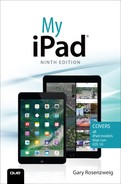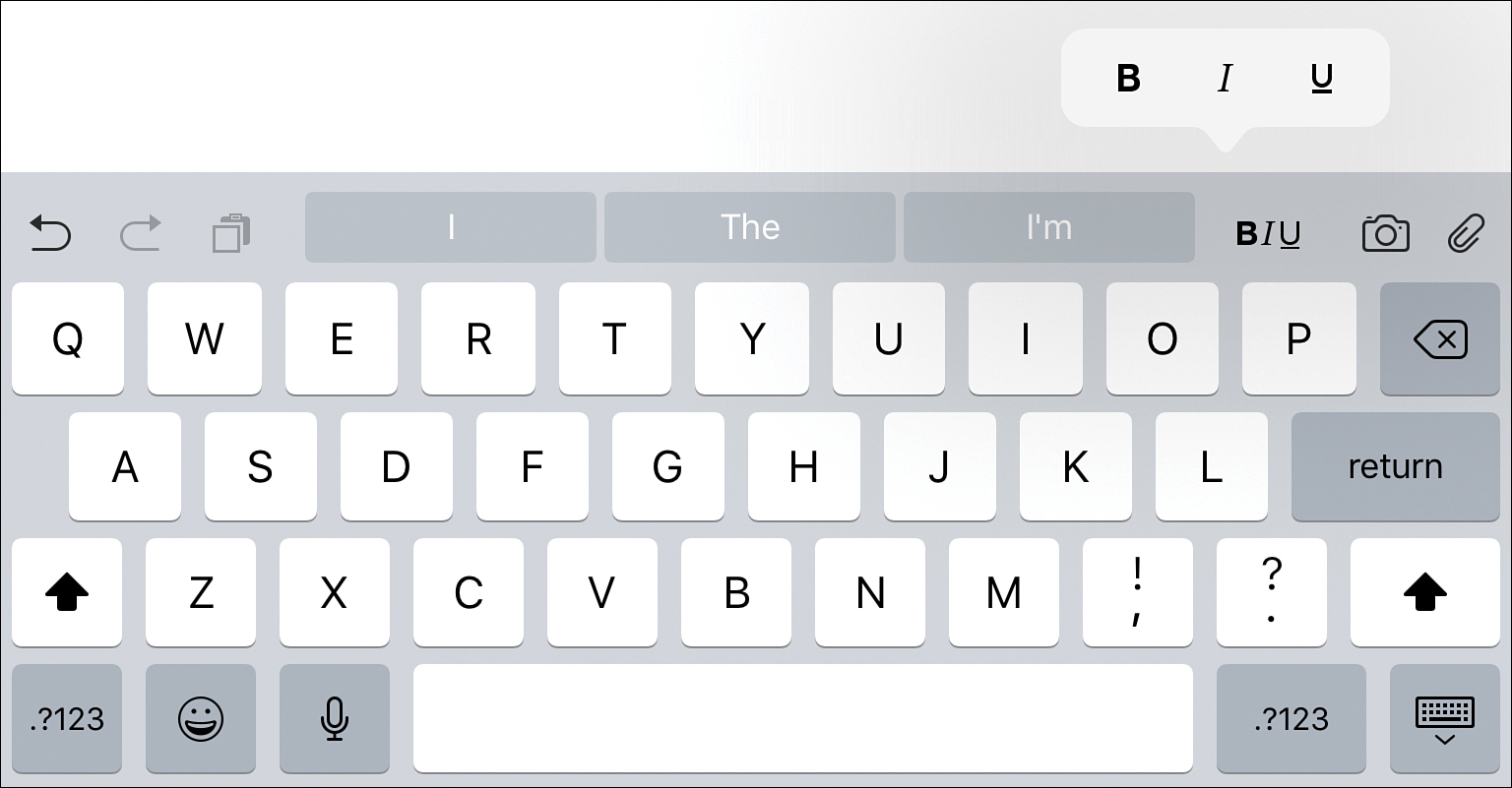1. Getting Started
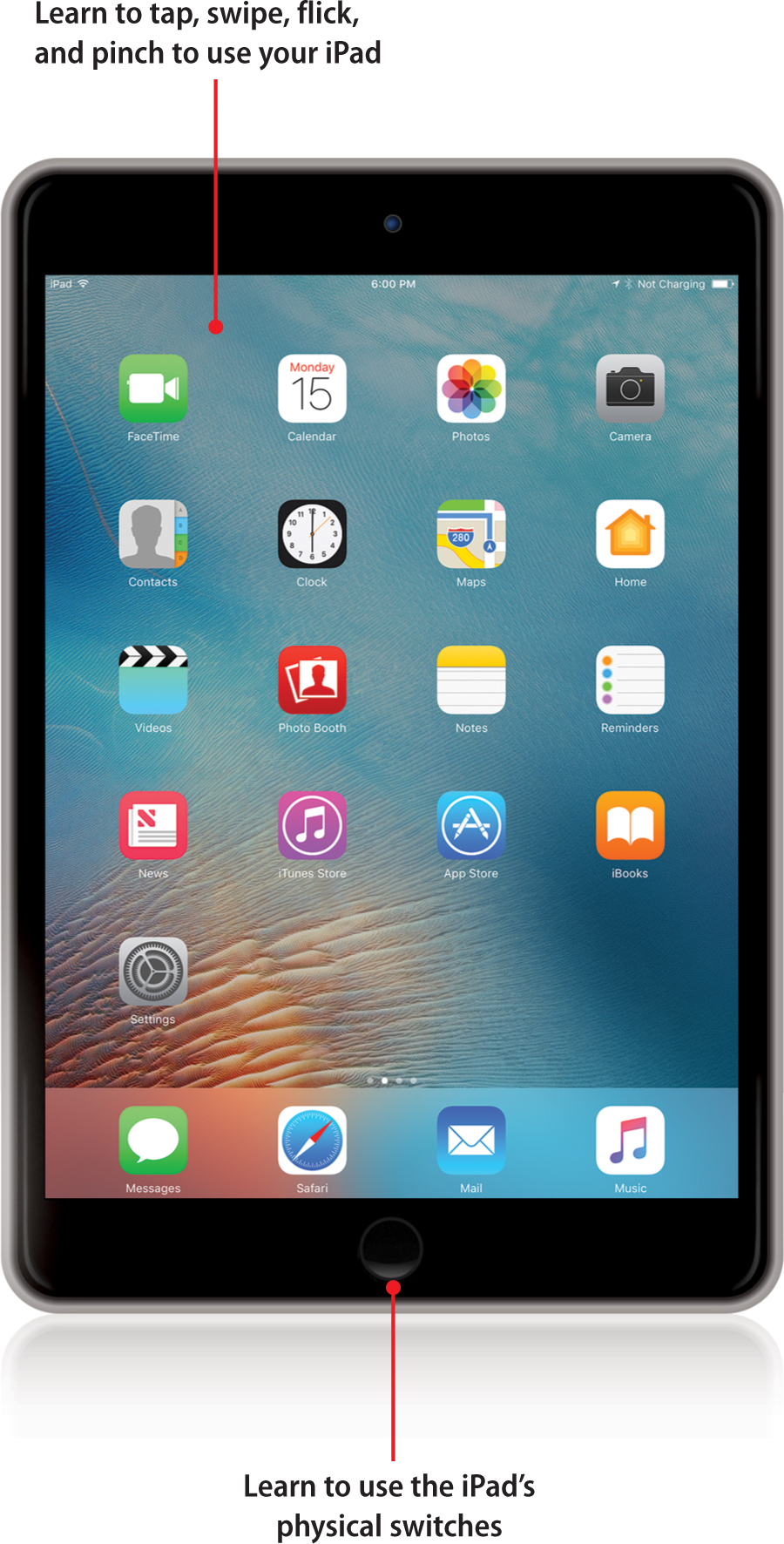
In this chapter, you learn how to perform specific tasks on your iPad to become familiar with the interface.
![]() Talking to Your iPad with Siri
Talking to Your iPad with Siri
Before you learn how to perform specific tasks on your iPad, you should become familiar with some basic concepts. If you have used an iPhone or iPod touch before, you already know how to use a touchscreen device. But if the iPad is your first such device, you need to take time to become accustomed to interacting with it.
Generations of iPads
The first thing you may want to do is identify which iPad you have and what features are available to you. There have been many versions of the iPad since the original appeared in 2010.

iPad Comparison Chart
iPad displays vary not only in size, with the iPad mini models being smaller than the other iPads, but also in pixel density. The retina display has four pixels for every one of a regular display. Whereas a non-retina display is 768×1024 pixels, a retina display is 1536×2048 pixels. This means photographs and text are crisper and clearer on the retina display. In fact, you can’t even distinguish the individual pixels with your eye unless you hold the iPad very close. The iPad Pro 12.9-inch has even more pixels at 2048×2732.
Time for a New iPad?
Note that the first four iPads in this list—the iPad, iPad 2, 3rd generation, and first iPad mini—are not compatible with iOS 10, the version of iOS discussed in this book. Because these models can’t run iOS 10, some of the latest third-party apps might not work, or won’t work very well.
Another difference between iPad models is the camera. Since the first model in 2010, the cameras on the iPad have improved, with higher quality and picture resolution.
Each iPad has also become a little more powerful with a faster processor at its heart. Other parts have picked up speed and power as well, processing graphics and accessing memory faster. Early models aren’t powerful enough to use features like voice dictation and advanced 3D game graphics.
iOS 10 New!
The primary piece of software on the iPad is the operating system, known as iOS. This is what you see when you flip through the screens of icons on your iPad and access default apps such as Mail, Safari, Photos, and iTunes.
This book covers iOS 10, the version released in September 2016. There have been ten generations of the software that runs iPhones and iPads. The original iPhone OS was developed for the first iPhone. The third version, iOS 3, worked on iPhones and the iPad. This latest version, iOS 10, works on the iPad 4th generation and newer. If you have an older version of the iPad, you will not be able to install iOS 10 and will be stuck with an earlier version. Many of the things you see on your older iPad will look different than what you see in this book, and some features will be missing entirely.
Some features and tasks in this book work the same in iOS 5 through 9, but you will not be able to use the latest features such as special Messages features, the redesigned Music and News apps, or keyword searching in Photos. To find out which version you are using and to learn how to update, you use the Settings app. In the Settings app, under the General settings, tap the About item. The About screen shows you information about your iPad, including its model number, serial number, version of iOS currently running, and available memory. You learn how to use the Settings app when you get to Chapter 2, “Customizing Your iPad.”
There are some changes in iOS 10 you will notice. For features that have changed significantly, or are completely new, we have added an indicator to the text and table of contents to help you easily locate them. When you see New!, be sure to check out those tasks to quickly get up to speed on what’s new in iOS 10.
The iPad Buttons and Switches
The iPad features a Home button, a Wake/Sleep button, and a volume control.
The Home Button
The Home button is probably the most important physical control on the iPad and the one that you will use the most often. Pressing the Home button returns you to the Home screen of the iPad when you are inside an application, such as Safari or Mail, and you want to get back to your Home screen to launch another app. You can also double press the Home button to switch between apps, as described in the section titled “Viewing Currently Running Apps” in Chapter 15, “The World of Apps.”
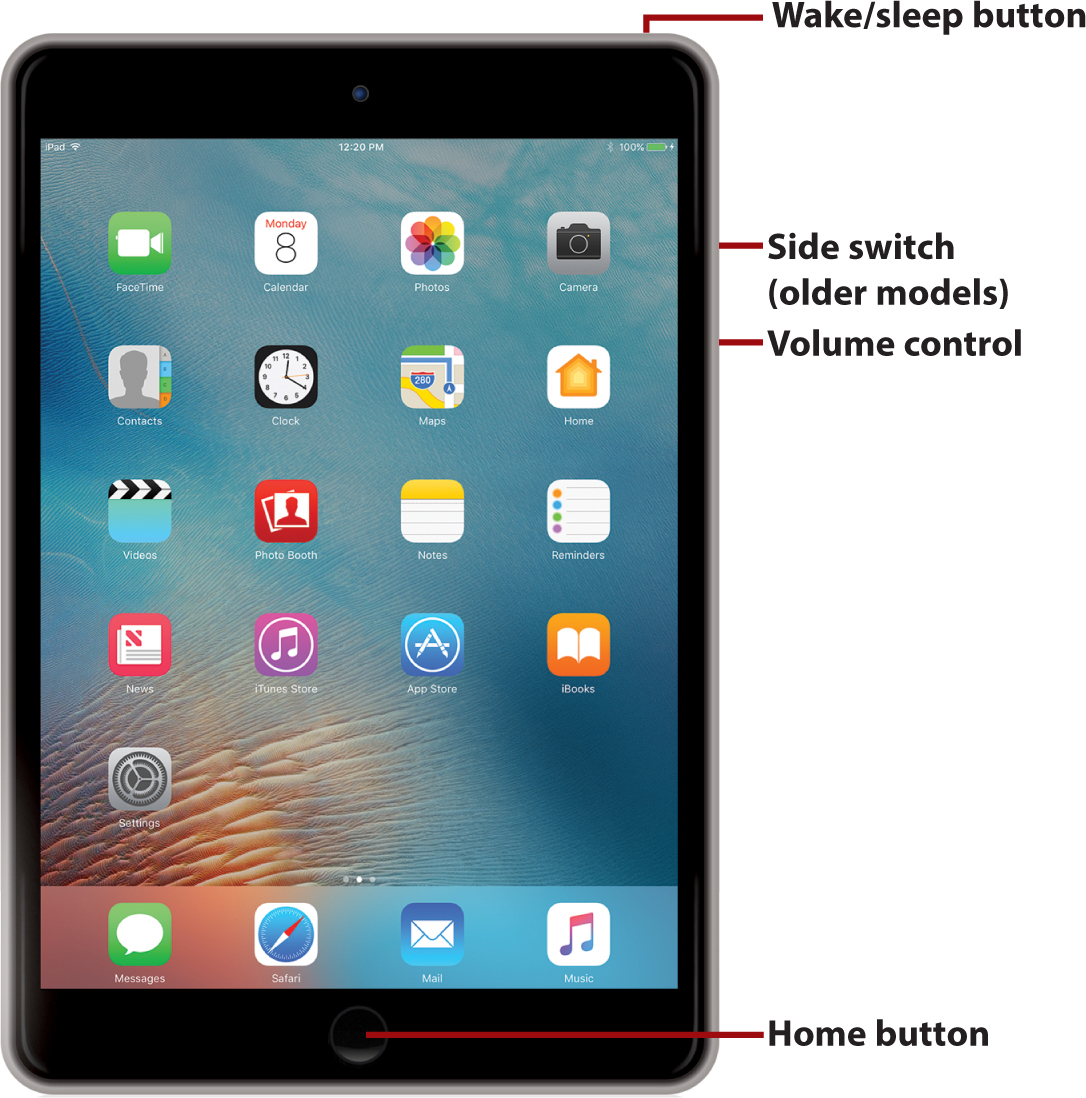
Few, if any, apps on the iPad have a way to quit. Instead, think of the Home button as the Quit button. It hides the current app and returns you to your Home screen. The app is actually still running, but hidden, in the background. It is usually unnecessary to truly “quit” an app. But if you really want to completely quit an app, see “Quitting Apps” in Chapter 15.
The Wake/Sleep Button
The primary function of the Wake/Sleep button (sometimes called the On/Off or Power button) at the top of your iPad is to quickly put it to sleep. Sleeping is different than shutting down. When your iPad is in sleep mode, you can instantly wake it to use it. You can wake the iPad from sleep by pressing the Wake/Sleep button again or by pressing the Home button.
Peek a Boo!
If you are using the Apple iPad Smart Cover, Smart Case, or the iPad Pro Smart Keyboard (see Chapter 18, “iPad Accessories”), your iPad goes to sleep when you close it and wakes up when you open it, as long as you use the default settings. Many third-party cases and covers also do this.
You can also use the Wake/Sleep button to shut down your iPad, which you might want to do if you leave your iPad for a long time and want to preserve the battery life. Press and hold the Wake/Sleep button for a few seconds, and the iPad begins to shut down and turn off. Confirm your decision to shut down your iPad using the Slide to Power Off button on the screen.
To start up your iPad, press and hold the Wake/Sleep button for a few seconds until you see the Apple logo appear on the screen.
When Should I Turn Off My iPad?
It is normal to never turn off your iPad. In sleep mode, with the screen off, it uses little power. If you plug it in to power at night or during longer periods when you aren’t carrying it with you, you don’t need to ever shut it down.
The Volume Control
The volume control on the side of your iPad is actually two buttons: one to turn the volume up, and the other to turn it down.
Your iPad keeps two separate volume settings in memory: one for headphones and one for the internal speakers. If you turn down the volume when using headphones and then unplug the headphones, the volume changes to reflect the last settings used when the headphones were not plugged in, and vice versa. A speaker icon and a series of rectangles appear on the screen to indicate the current level of volume.
The Side Switch
The side switch is a feature on older iPads. The switch can do one of two things: It can be set as a mute switch or an orientation lock. You can decide which function this button performs in your iPad’s Settings app, in the General category. (Those options appear only if you are using an iPad with a side switch.)
If you choose to use this switch as a mute switch, it mutes all sound if switched to the off position. You see a speaker icon appear briefly in the middle of the screen when you do this. A line through the icon means you just muted the sound; otherwise, you just unmuted your iPad. By default, the iPad comes with the switch configured to mute.
If you choose to use this switch as an orientation lock, it does something else entirely. Your iPad has two primary screen modes: vertical and horizontal. You can use almost every default app in either orientation. For example, if you find that a web page is too wide to fit on the screen in vertical orientation, you can turn the iPad sideways and the view changes to a horizontal orientation.
When you don’t want your iPad to react to its orientation, slide the iPad side switch so that you can see the orange dot, which prevents the orientation from changing. When you need to unlock it, just slide the lock off.
This comes in handy in many situations. For instance, if you are reading an eBook in bed or on a sofa while lying on your side, then you might want vertical orientation even though the iPad is lying sideways.
Newer model iPads don’t have a side switch. The controls for orientation lock and mute appear in the Control Center, which is covered later in this chapter in the task “Open Control Center.”
Orientation and Movement
In addition to the physical switches you see on your iPad, the entire iPad is a physical control.
Your iPad knows which way it is oriented, and it knows if it is being moved. The simplest indication of this is that it knows whether you hold it vertically with the Home button at the bottom or horizontally with the Home button to one of the sides. Some apps, especially games, use the screen orientation of the iPad to guide screen elements and views.
Shake It Up!
One interesting physical gesture you might perform is the “shake.” Because your iPad can sense movement, it can sense when you shake it. Many apps take advantage of this feature and use it to set off an action, such as shuffling songs in the Music app, erasing a drawing canvas, or as an “undo” function.
Screen Gestures
Who knew just a few years ago that we’d be controlling computing devices with taps, pinches, and flicks rather than drags, key presses, and clicks? Multitouch devices such as the iPhone, iPod touch, and the iPad have added a new vocabulary to human-computer interaction.
Tapping and Touching
Because there is no mouse, a touchscreen has no cursor. When your finger is not on the screen, there is no arrow pointing to anything.
A single, quick touch on the screen is usually called a “tap” or a “touch.” You usually tap an object on the screen to perform an action.
Occasionally you need to double-tap—two quick taps in the same location. For instance, double-tapping an image on a web page zooms in to the image. Another double-tap zooms back out.

Pinching
The screen on the iPad is a multitouch screen, which means it can detect more than one touch at the same time. This capability is used with the pinch gesture.
A pinch (or a pinch in) is when you touch the screen with both your thumb and index finger and move them toward each other in a pinching motion. You can also pinch in reverse, which is sometimes called an “unpinch” or “pinch out.”
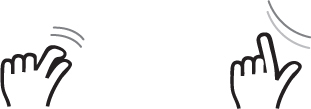
An example of when you would use a pinch/unpinch gesture would be to zoom in and out on a web page or photograph.
Dragging and Flicking
When you touch the screen, hold your finger down, and drag your finger in any direction along the screen, the effect is that the content on the screen moves. For instance, if you are viewing a long web page and drag up or down, the page scrolls. Sometimes an app lets you drag content left and right as well.

What if you have a long web page or a list of items inside an app? Instead of dragging the length of the screen, lifting your finger up, and moving it to the bottom to drag again, you can “flick.” Flicking is like dragging, but you move quickly and lift your finger off the screen at the last moment so that the content continues to scroll after you have lifted your finger. You can wait for it to stop scrolling or touch the screen to make it stop.

Jump Up
In many apps, such as Settings, Mail, and Safari, you can quickly jump to the top of a screen by tapping near where the time is shown at the top-middle of the screen.
Pull Down and Release to Update
A common gesture is to tap in a list of items, drag down, and release. For instance, you would do this in Mail to get new messages. With your email inbox on the left, tap and drag down in the list. A blank space appears above the first message, and an activity indicator appears to let you know more mail is being downloaded.

Many Apple and third-party apps use this gesture to let you signal that you want to update the list of items. So if you don’t see an obvious “update now” button, try this gesture.
Four-Finger Gestures
You can perform one of three special functions by using four or five fingers at a time on the screen. If you put four or five fingers on the screen and pinch them all together, you will be taken out of your current app and back to the Home screen, similar to when you press the Home button.

You can swipe left or right using four or more fingers to quickly page between running apps without going to the Home screen first. Swiping up with four fingers will bring you to the multitask switcher. See “Viewing Currently Running Apps” in Chapter 15.

Learning Your Way Around
When you pick up your iPad and touch either the Wake/Sleep button or the Home button to activate the screen, you see what is called the Lock screen. From there, you unlock your iPad and return to the last screen you were using—either the Home screen or an app’s screen.
Let’s look at the different types of screens you see every day on your iPad, and how to navigate between them.
The Lock Screen
When you first wake up your iPad, you’re on the Lock screen. This shows a colorful picture with some very basic information. The largest element is the time. Under that is either the battery level or the date. It alternates between them every few seconds. The battery status is at the top right, and your Wi-Fi status is at the top left.

From the Lock screen there are four places you can go. You can swipe left to right to go to the Widgets screen. You can swipe from the very top of the screen down to go to the Notifications screen. Those two screens are covered in more detail shortly. You can also swipe right to left to bring up the Camera app to take a quick picture. Read about the Camera app in Chapter 9, “Taking and Editing Photos.” You can also press the Home button to exit the Lock screen and go to the Home screen.
In every version of iOS before iOS 10, you pressed the Home button or the Wake/Sleep button and then saw the Lock screen with a Slide to Unlock message at the bottom. You slid your finger across that message to unlock the screen.
But things have changed with iOS 10. Now you simply press the Home button a second time to unlock your iPad. So one press wakes your iPad and takes you to the Lock screen; the second press unlocks your iPad and takes you to the Home screen.
If your iPad supports Touch ID and you have Touch ID set, which you should, you can simply hold your finger over the Home button instead of pressing it that second time. You can even get to the Home screen quickly by pressing the Home button and releasing it while keeping your thumb over the button to trigger Touch ID. See “Make Access Easier with Touch ID” in Chapter 2.
The Home Screen
Think of the Home screen as a single screen but with multiple pages that each features different app icons. At the bottom of the Home screen are app icons that do not change from page to page. Find out how to add more apps to your iPad in the tasks in Chapter 15.
The number of pages on your Home screen depends on how many apps you have. The number of pages you have is indicated by the white dots near the bottom of the screen, just above the bottom icons. The brightest dot represents the page you are currently viewing. You can move between pages on your Home screen by dragging or flicking left or right.
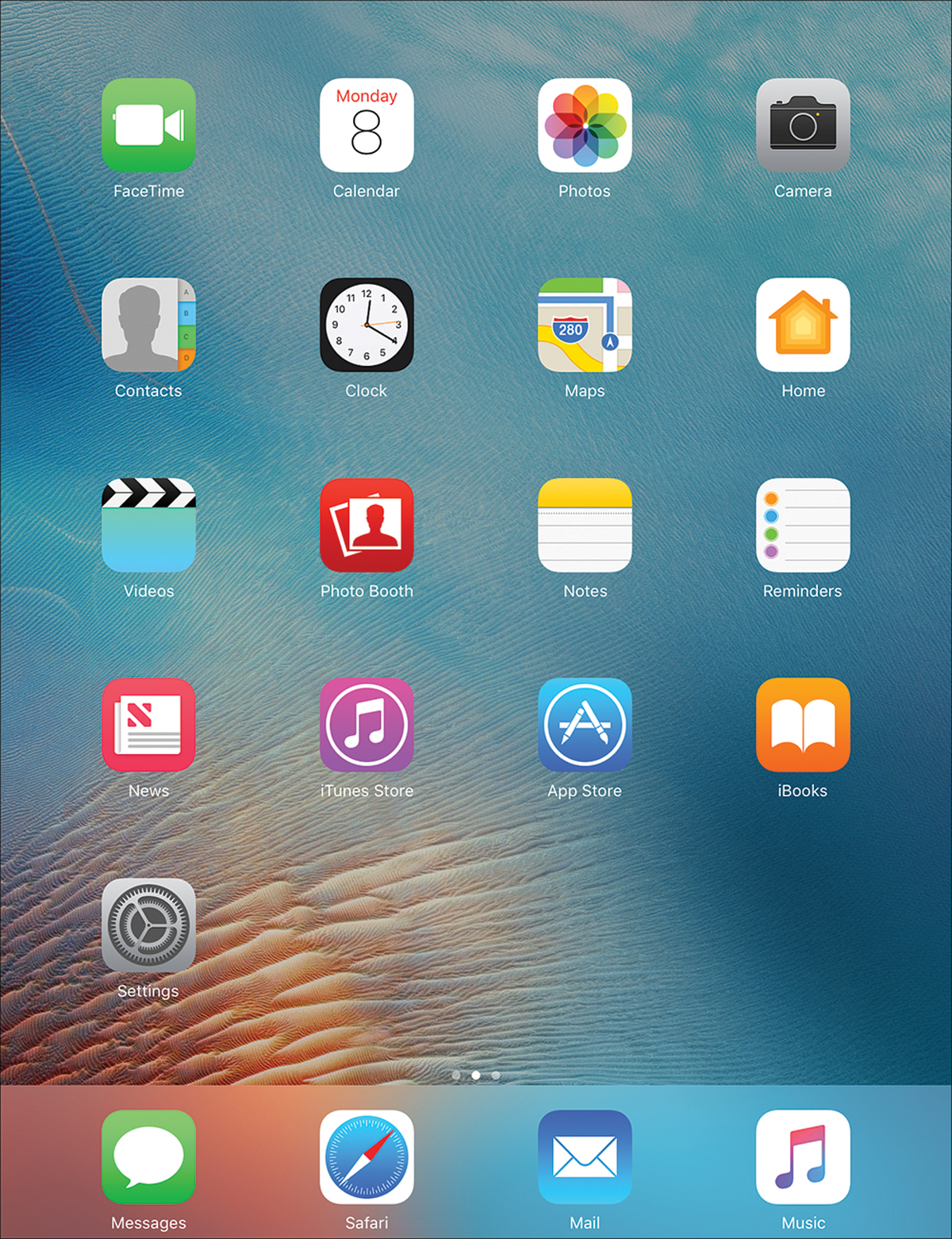
In addition to jumping into an app by tapping the app icon, there are three other screens you can get to from the Home screen. If you swipe left to right from the initial Home screen, you go to the Widgets screen. If you swipe down from the very top of the screen, you go to the Notifications screen. If you swipe down from the center of the screen, you go to the Search screen.
The Search Screen
If you are on your Home screen looking at page one of your app icons, you can drag from the center of the screen downward to bring up a Spotlight Search field at the top and a keyboard at the bottom. This allows you to search your iPad for apps, contacts, events, and other information.
You can type in anything to search for a contact, app, email message, photo, and so on. You don’t have to define what type of thing you want to search for.
1. From the Home screen, tap in the center of the screen and drag down. If you’ve been using your iPad for a while and have Siri enabled, you will see suggestions for apps, contacts, and other content on this screen even before you type a search term.
Drag from the Center, Not the Top
Don’t start at the very top of the screen, as dragging from there brings up Notifications Center instead. This can be a bit tricky; so if you do accidentally open Notifications Center, just swipe it back up out of the way and try again.
2. Type a search term using the on-screen keyboard.

3. You see a list of items on your iPad that match the search term. The search results show apps, calendar events, email messages, reminders, or even web search results.
4. Tap the Search button on the keyboard to dismiss the keyboard and complete the search.
5. Tap the X in the search field to clear the search and start again.
6. Tap any of the items to go to the appropriate app and view the content.
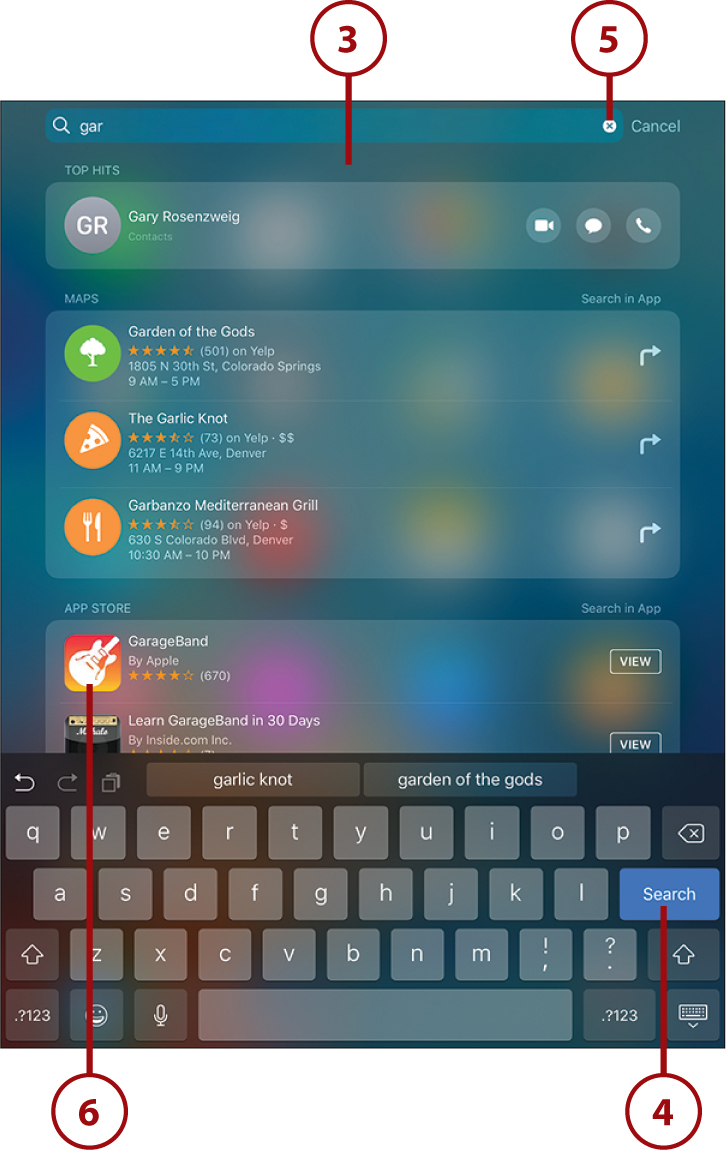
How Do I Get Out of Here?
To exit the Search screen instead of completing a search, just tap outside of the search results or press the Home button. This takes you back to the Home screen.
The Widgets Screen New!
You can get to the Widgets screen one of three ways: swipe left to right on the Lock screen, swipe left to right on the primary Home screen, or swipe left to right on the Notifications screen.
The Widgets screen is filled with useful widgets or modules that present information and allow you to take simple actions.
1. Swipe from the left to the right from the left-most page of apps on the Home screen.

2. In large type at the top of the screen is today’s date.
3. A summary of today’s weather is on the left.
What Are Widgets?
Underneath the weather and date, the rest of the screen is filled with widgets. You can completely customize these, removing ones you don’t need and adding new ones. The four shown in this task are four default widgets. The default widgets may vary in future updates to iOS.
4. The Calendar widget shows you your next scheduled event.
5. Tap an event to open the Calendar app and go right to it.
6. The Siri App Suggestions widget usually shows your recently used apps. Tap any of the icons to go directly to that app.
7. The day’s top news story is the next widget. Tapping it takes you to that story in the News app.
8. If you have any items set for today in the Reminders app, you see them in the Reminders widget. Tap an item to open the Reminders app. Or, tap the circle to the left of the item to mark the item as completed without going to the Reminders app at all.
9. If you have more widgets than can fit on the screen, swipe up to see them.
10. At the top of the Widgets screen is a search field that you can use to search for anything on your iPad. It is another way to access the Search screen mentioned earlier in this chapter.
11. At the bottom of the list is an Edit button that enables you to customize what you see on the Widgets screen. Tap it.

12. Tap the red – buttons next to any item to remove that widget from the Widgets screen.
13. Tap the green + buttons next to items to add them to the Widgets screen.
14. Tap the handles to the right of any item and drag up or down to rearrange the order of items on the Widgets screen.
15. When using your iPad in horizontal orientation, the widgets are shown in two columns. You can see which widgets will appear in which columns based on whether they appear under the Left Column or Right Column lists.
16. Tap Done to save your changes and return to the Widgets screen.

Results May Vary
You might find that some widgets work differently, or show different information, depending on whether you accessed the Widgets screen from the Lock screen or Home screen. From the Lock screen you haven’t entered your passcode or used Touch ID to log in to your iPad so that might restrict what is allowed.
The Notifications Screen
If you swipe down from the very top of the Lock screen or Home screen, you go to the Notifications screen, which is a list of recent notifications, such as calls, messages, emails, or app alerts.
In most cases you can tap the notification to take appropriate action. For instance, tapping a notification that you have a text message takes you into the Messages app and right to that conversation so you can respond.
From the Notifications screen you can press the Home button to return to either the Lock screen or the Home screen, depending on where you came from originally.
If you happen to be using your iPad when a notification arrives, you also see the notification pop up as an overlay on part of your screen. You can tap the notification to take action, drag it up to dismiss it, or ignore it so it goes away after a few seconds.

If you iPad is nearby but you are not using it and it is locked, then you might also notice notifications appearing on the screen as they happen. When the iPad is locked, the screen turns on and you see the notification on the Lock screen. You can swipe right to left across it to see View or Clear buttons. If you do nothing, the screen simply turns off again after a few seconds. When you go to wake up your iPad later, you see the notification on the Lock screen again.
Virtual Buttons and Switches
Several interface elements are more complex than a simple button. In typical Apple style, these elements are often self-explanatory, but if you have never used an iPad before, you might find some that give you pause.
Switches and Option Lists
A switch is a simple button that allows you to turn something on or off. You just tap the switch to change it—no need to slide it. The background of a switch turns green when the switch is “on.”
For example, the switch in the figure indicates whether labels in the Maps app are displayed in English. Tapping the switch changes the position of the switch.
But the Distances setting above that offers another way to switch between options that works better when the setting isn’t as simple as on or off/yes or no. In that case, you would tap the option you want, which would then display a check mark like the one next to In Miles.
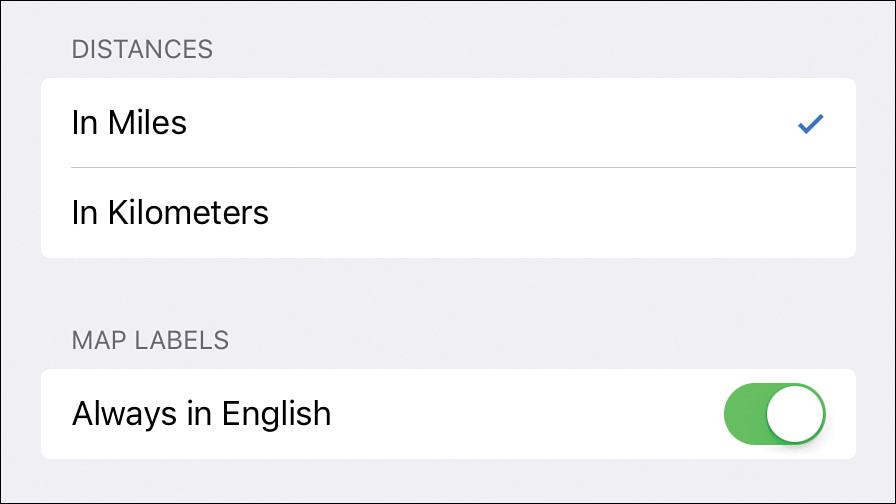
Toolbars
Some apps have a set of controls in a toolbar at the top of the screen. Buttons shown there are sometimes nothing more than a word or two that you can tap to trigger an action. The toolbar might disappear or the buttons might vary depending on the mode of the app. If a toolbar disappears, a tap on the screen brings it up again.
An example of a toolbar is in the iTunes Store app. When you are viewing the music section of the iTunes Store, it has a button to access Genres, a title in the middle, a button that brings up more controls, and a search field. But, this toolbar can change. For instance, if you switch from viewing the Music screen to viewing Top Charts, you get a set of buttons that let you switch between Music, Movies, TV, or Audiobook charts.

Menus
Often tapping a single button in a toolbar brings up more buttons or a list of choices, which are like menus on your computer. The choices in the list are usually related. For example, a button in Safari gives you many different ways to share a web page.

Tab Bars
Sometimes you see a row of buttons at the bottom of the screen that function similarly to toolbars, but each button represents a different mode for the app. For instance, at the bottom of the iTunes Store app, you see a tab bar that you use to switch between various screens: Music, Movies, TV Shows, Top Charts, Genius, and Purchased.

Entering Text
Entering text on your iPad means interacting with an on-screen keyboard or speaking to your iPad. Even if you are not a writer, you need to enter text quite often to input addresses in the web browser or to compose messages and emails.
Using the On-Screen Keyboard
The on-screen element you might interact with the most is the keyboard. It pops up from the bottom of the screen automatically whenever you are doing something that requires entering some text.
Keyboard Modes
An on-screen keyboard can have many different modes. With the default keyboard, the first mode shows you letters and a few punctuation marks. There are two Shift keys that enable you to enter uppercase letters. You also have a Backspace key and a Return key.
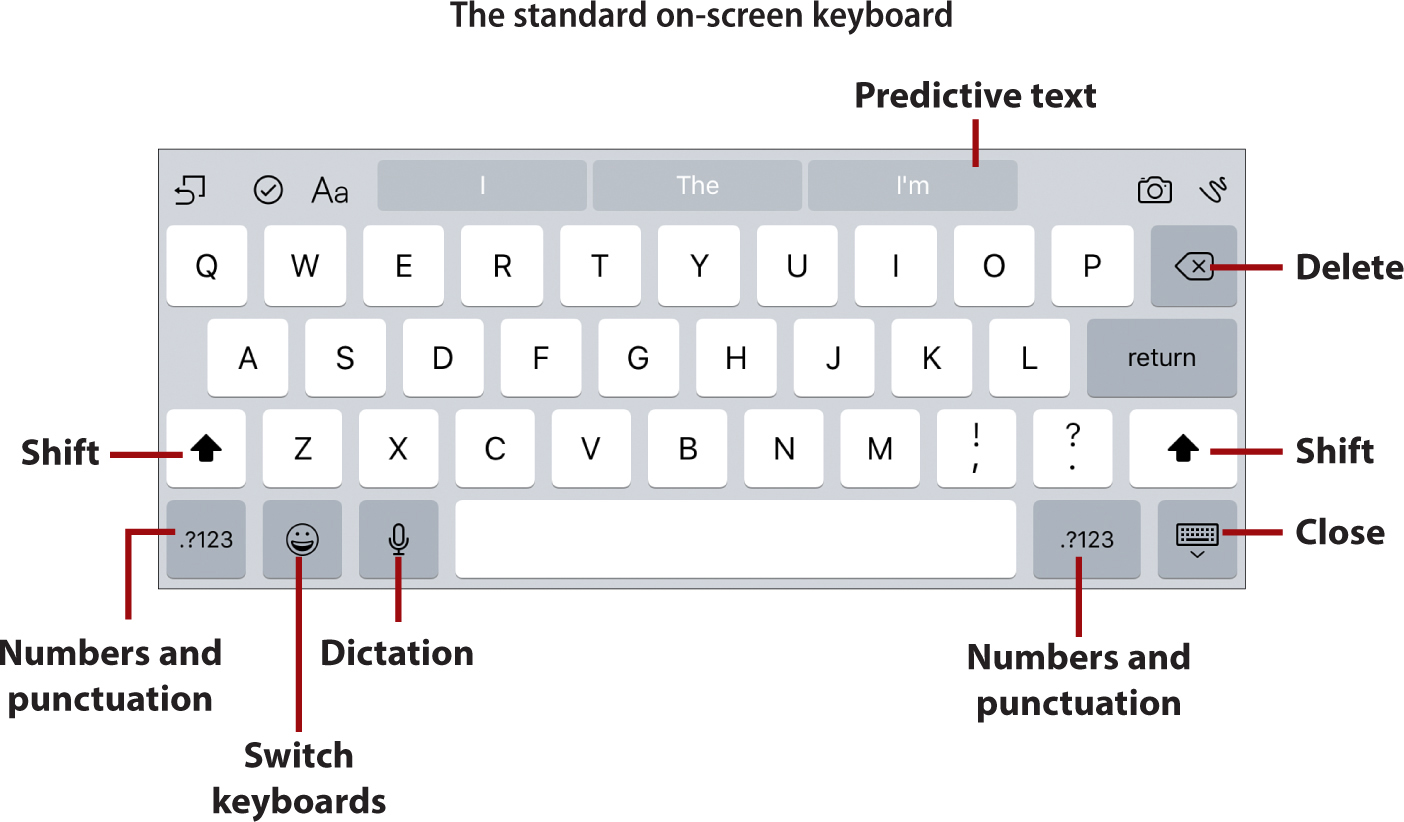
Is There a Quicker Way to Capitalize?
To capitalize a word, you tap the Shift key, and then type the letter, right? You can. But a faster way is to tap the Shift key; then, without letting your finger off the screen, drag it to the letter and release in a single tap-slide-release action.
You can do the same with numbers and punctuation by tapping the .?123 key and sliding and releasing over the key you want.
To enter numbers and some other punctuation, tap the .?123 key to switch your keyboard into a second mode for numbers and punctuation. In addition, this mode includes an Undo key for undoing your recent typing. To return to the letters, just tap the ABC key.

From the numbers and punctuation mode, you can tap the #+= key to go to a third keyboard mode that includes less frequently used punctuation and symbols. On this screen, the Undo button is now a Redo button that you can use in case you tap Undo by mistake.

There are other keyboard variations. For instance, in some cases if you type in a location that needs a web address, a keyboard that doesn’t have a spacebar appears. Instead it has commonly used symbols such as colons, slashes, underscores, and even a .com button.
Not only are there other keyboard variations, there are completely different keyboards you can use. The iPad has many non-English language keyboards, and even a keyboard composed of little images (smiley faces and other pictures) called Emoji. Plus, you can add third-party keyboards from developers. Adding new keyboards is covered in the task “Modifying Keyboard Settings” in Chapter 2. Find out more about typing emoji characters when you read about the Messages app in Chapter 8, “Communicating with Email and Messaging.”
Undocking and Splitting the Keyboard
You can also split the keyboard and/or move it away from the bottom of the screen. This can make it easier for you to type if you are holding your iPad with two hands. Grasp it with your hands on either side of the iPad, and type with your thumbs.
1. Undock or split your keyboard by tapping and holding the keyboard button at the bottom-right corner.
2. Select Undock to move the keyboard up from the bottom of the screen and have control of its vertical position.
3. Select Split to undock the keyboard and also split it in half so you can reach all the keys from either side with your thumbs. You can also do this by tapping the keyboard button and dragging up.

4. When the keyboard is undocked or split, you can tap and hold the keyboard button to drag it vertically to find the best position for you. If you tap and hold but do not drag, then you get the option to Merge, or Dock and Merge.
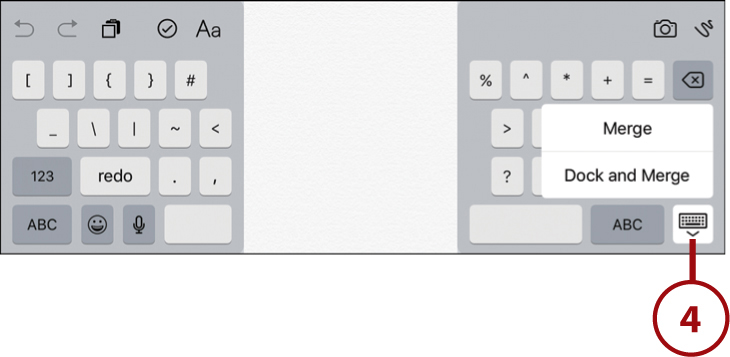
5. Tap Merge to merge the two halves of the keyboard into one. You can also do this by tapping in the middle of the keyboard and pinching inward.
6. Tap Dock and Merge to merge the halves and also lock the keyboard to the bottom of the screen. You can also do this by dragging the keyboard all the way down to the bottom of the screen.
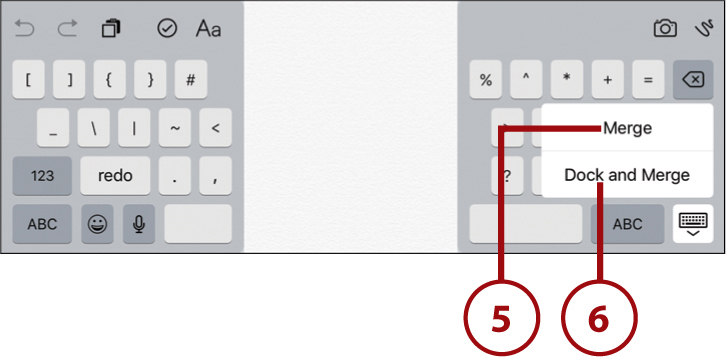
Using the Keyboard Shortcut Bar
Above the letter and number keys on the on-screen keyboard is the shortcut bar. This narrow horizontal strip can contain a variety of buttons and some predictive text shortcuts. We look at predictive text in the next section.
The buttons in the shortcut bar vary depending on which app you are using and even what type of text you are typing within the app.
If you don’t see the shortcut bar, but instead see a narrow line with a smaller white line in the center, then tap and drag that small white line up to reveal the shortcut bar.
So far, we’ve been looking at the keyboard as it appears in the Notes app. Let’s take a tour of the shortcut bar as it appears when typing in Notes.
1. Tapping this button brings up Undo and Paste from the clipboard buttons. If you have text selected, it instead brings up Cut, Copy, and Paste buttons.
2. This undoes the last insertion or edit.
3. This redoes the last undo.

4. You can paste text you may have previously copied into the clipboard. This is similar to using Command+v or Control+v on a desktop computer.
5. In Notes, you get a button to begin writing a checklist.
6. You can also choose from a variety of other text styles such as Title, Heading, Body, and so on.
7. You can tap this button to take a picture with your iPad’s camera or insert a photo from your library.
8. Notes includes a special sketch function that lets you add a drawing to your note. We take a closer look at that in Chapter 6, “Organizing Your Life.”

Using Predictive Text
You might have noticed that while you are typing, three buttons with words in them appear on top of the keyboard in the shortcut bar. This is the predictive text feature of the keyboard, also sometimes referred to by Apple as QuickType.
As you’re typing, you can use these three buttons to complete a word with just one tap. For instance, you might be typing the word “Clever.” As you type, the three buttons change to represent what comes closest to the letters you have typed so far. When you have typed “Cle,” you might get “Clearer” and “Clear” as suggestions. But when you get to “Clev,” you will probably see “Clever” as one of the buttons. Simply tap that button and the word is completed without you needing to type “r.” Notice that a space is automatically inserted as well. If the word you inserted was the end of your sentence, simply tap the spacebar two times, and a period is inserted and the app is ready to start a new sentence.

Predictive text does more than look at the letters in the word you are typing; it also considers the context of the whole sentence. For instance, if you type “pur,” you might get “put” and “pure” as suggestions. But if you type “color pur,” you will get “purple” as a suggestion.
Also note that the leftmost button of the three usually displays the text exactly as you have typed it, but with quotes around it. This allows you to type a name or unusual word without having autocorrect get in the way.
Predictive text also looks at which app you are using and what the situation involves. For instance, it might suggest different words based on the person whom you are emailing, whether it is a work colleague or friend. When you respond to text messages in the Messages app, you might see “Yes” and “No” appear automatically when you are responding to a question. If someone messages you to ask whether you want to meet at 6:00, 7:00, or 8:00, those three options are offered before you even type the first letter of your response.
Dictating Text
You can also dictate text using your voice rather than typing on the keyboard. Almost any time you see a keyboard, you should also see a small microphone button to the left of the spacebar. Tap that and you are prompted to speak to your iPad. You need to be connected to the Internet through a Wi-Fi or cellular connection for this to work.
1. Tap the microphone button on the keyboard to begin dictating. If this is the first time you are doing it, you might be asked for permission to enable the feature.
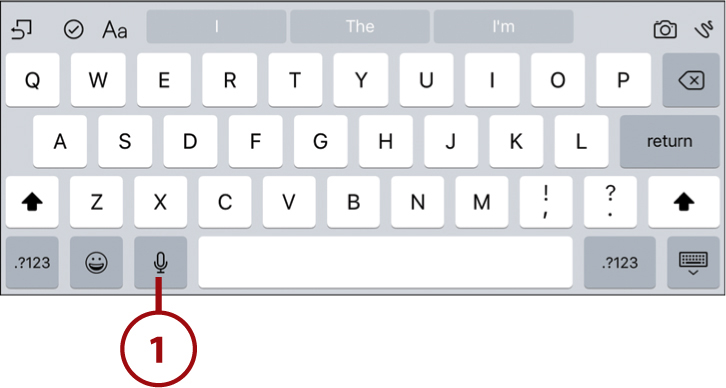
2. The keyboard is replaced with a waveform line that vibrates as you speak. Speak a few words or a sentence or two. As you speak, the text appears in your document or text field, though it may lag behind by a few seconds.
3. Tap Done when you are finished speaking. You can now edit the dictated text as needed before sending it.
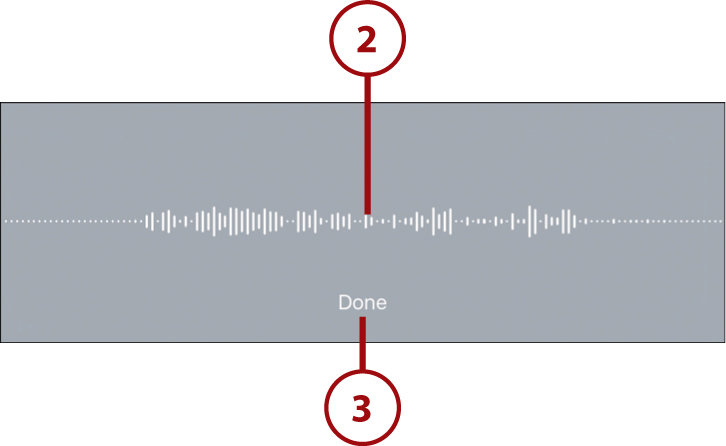
Speak somewhat slowly and clearly, and in segments about the length of a sentence for best results. Of course, this feature isn’t perfect. Pay careful attention to what is transcribed and correct any mistakes using the keyboard. Over time you will get better at speaking in a way that minimizes mistakes.
Editing Text
Editing text has its challenges on a touchscreen device. Even though you can touch any portion of your text on screen, your fingertip is too large for the level of precision you usually get with a computer mouse and cursor. To compensate, Apple developed an editing technique using a magnifying glass area of the screen that you get when you touch and hold over a piece of text.
For example, if you want to enter some text into a field in Safari, touch and hold on the field. A circle of magnification appears with a cursor placed at the exact location you selected.

When you find the exact location that you want to indicate, release your finger from the screen. A variety of options then display, depending on what kind of text you selected, such as Select, Select All, and Paste. You can ignore the options presented and start typing again to insert text at this location.
Copying and Pasting
You can copy and paste text inside an app, and between apps, on your iPad. Here’s how you might copy a piece of text from one place in a document to another in the Notes app.
1. Launch Notes. If you don’t have any notes yet, create one by typing some sample text.

2. Touch and hold over a word in your note. The Select/Select All pop-up menu appears.
3. Choose Select.

4. Some text appears highlighted surrounded by dots connected to lines. Tap and drag the dots so the highlighted area is exactly what you want.
5. Tap Copy.
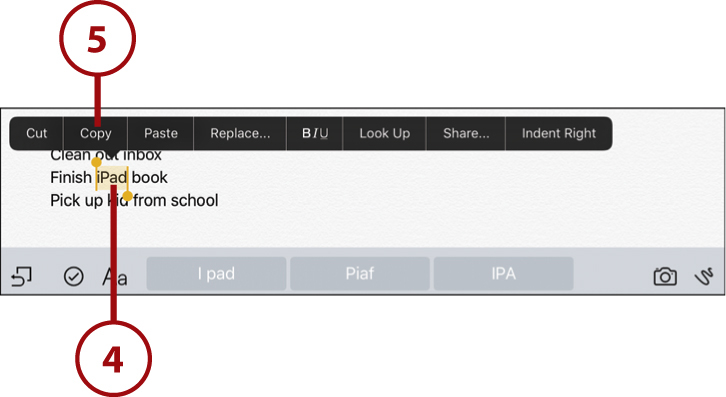
6. Alternatively, you can tap this icon on the keyboard shortcut bar to bring up Cut, Copy, and Paste icons, and then choose the Copy icon.

Variations
In other apps, you might find the Cut, Copy, and Paste icons already visible on the keyboard shortcut bar; and in still other apps, you might not find this alternative at all.
7. Tap one time at the bottom of the document to bring up a pop-up menu with the Paste command.
8. Tap Paste to insert the copied text. Alternatively, you can use the same method as in step 6 to paste.
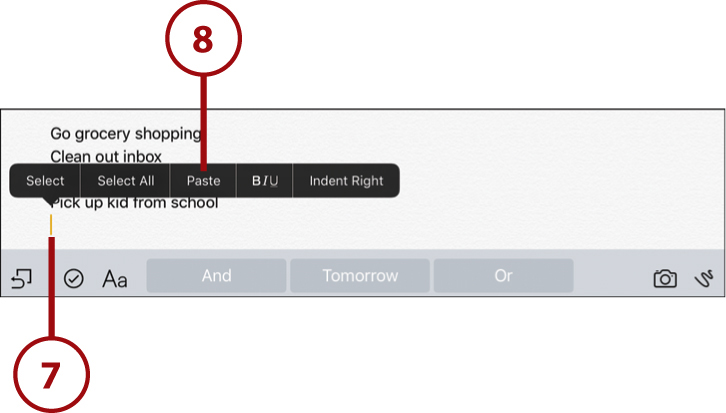
Talking to Your iPad with Siri
Siri is another way to communicate with your iPad. You can use your voice and speak commands to your iPad, and Siri responds. It either gives you information or takes action using one of the apps on the iPad.
To use Siri, you need to make sure you have Siri turned on in the Settings app. Then, you use the Home button to activate Siri. Chapter 2 explains how to work with the Settings app.
Asking Siri Questions
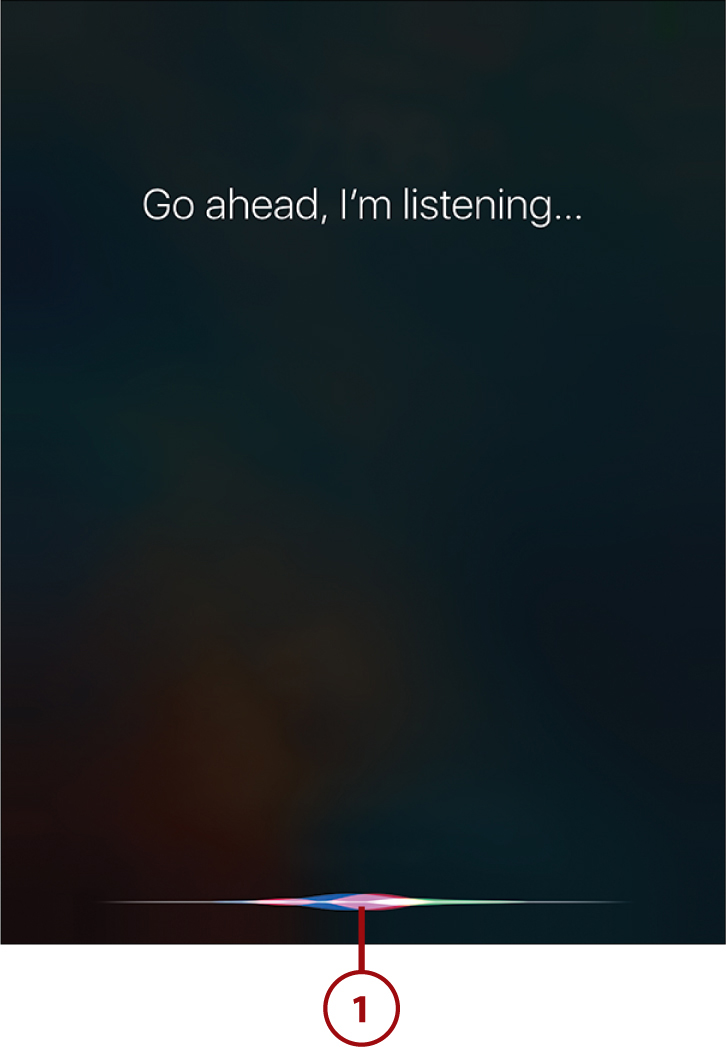
1. Press and hold the Home button for about a second. The Siri interface pops up, showing a waveform line at the bottom of the screen that reacts to the sound of your voice.
If you hesitate for a few seconds, you are shown a list of examples of things you can ask Siri.
2. Speak clearly at a normal pace and say, “What’s the weather going to be like tomorrow?” As you speak, the words appear near the top of the screen. When you stop speaking, Siri attempts to perform an action based on those words.
3. In this case, a short weather forecast appears.

4. Siri also responds with a statement and speaks it audibly. The text of the response typically appears above the screen content.
5. You can ask Siri another question by tapping the microphone button at the bottom of the screen.
6. If you wait for the list of suggestions to appear, you also see a question mark appear at the bottom left. Tap it to get a detailed list of apps that Siri can interact with, and things you can say for each app.
Siri Tips
To use Siri, you must have a connection to the Internet. It can be a Wi-Fi connection or a mobile connection. When you speak text, the audio is transmitted to Apple’s servers to convert it to text and interpret the command. The results are sent back to your iPad.
It is best to speak clearly and to limit background noise. Using Siri in a quiet room works better than in a crowded outdoor space or in a car with the radio on, for instance.
Because Apple’s servers control Siri, they can update Siri’s capabilities at any time. For example, originally Siri did not understand a request for local sports scores, but after an update this functionality was added.
You can use Siri to perform many tasks on your iPad without typing. For example, you can search the Web, set reminders, send messages, and play music. Throughout the rest of this book, look for the Siri icon for tips on how to use Siri to perform a task related to that section of the book.
Using Control Center
The Control Center is a set of buttons and switches that you can bring up from the bottom of your screen in almost any mode and in almost any app while using your iPad. The exact controls shown depend on which iPad model you own, which capabilities you have enabled or disabled in Settings, and even what other devices you have available on your network.

1. To bring up the Control Center, swipe up from the very bottom of the screen. If you are having trouble, try starting below the screen and swiping up onto the screen area all the way to the top.
2. The upper-left corner of the Control Center features a set of switches. The first one allows you to quickly switch into Airplane Mode, which turns off Wi-Fi and Bluetooth (as you might be asked to do during takeoff and landing on an airplane). The next two are individual switches for Wi-Fi and Bluetooth. So you can turn on Airplane Mode and then re-enable Wi-Fi only if your flight has Wi-Fi service.
3. You can quickly switch to Do Not Disturb mode, which silences all notifications.
4. This button mutes your iPad. If you have an older iPad with a side switch, and you have set that side switch to act as a mute switch, then this button might not appear here.
5. This button locks your iPad’s orientation. If you have an older iPad with a side switch, and you have set that side switch to act as an orientation lock, then this button might not appear here.
6. You can use this slider to adjust the brightness of your screen.
7. The AirPlay Mirroring button lets you choose a device to mirror your iPad’s screen to, assuming you have such a device connected to your network. We look at AirPlay in Chapter 4, “Playing Music and Video.”
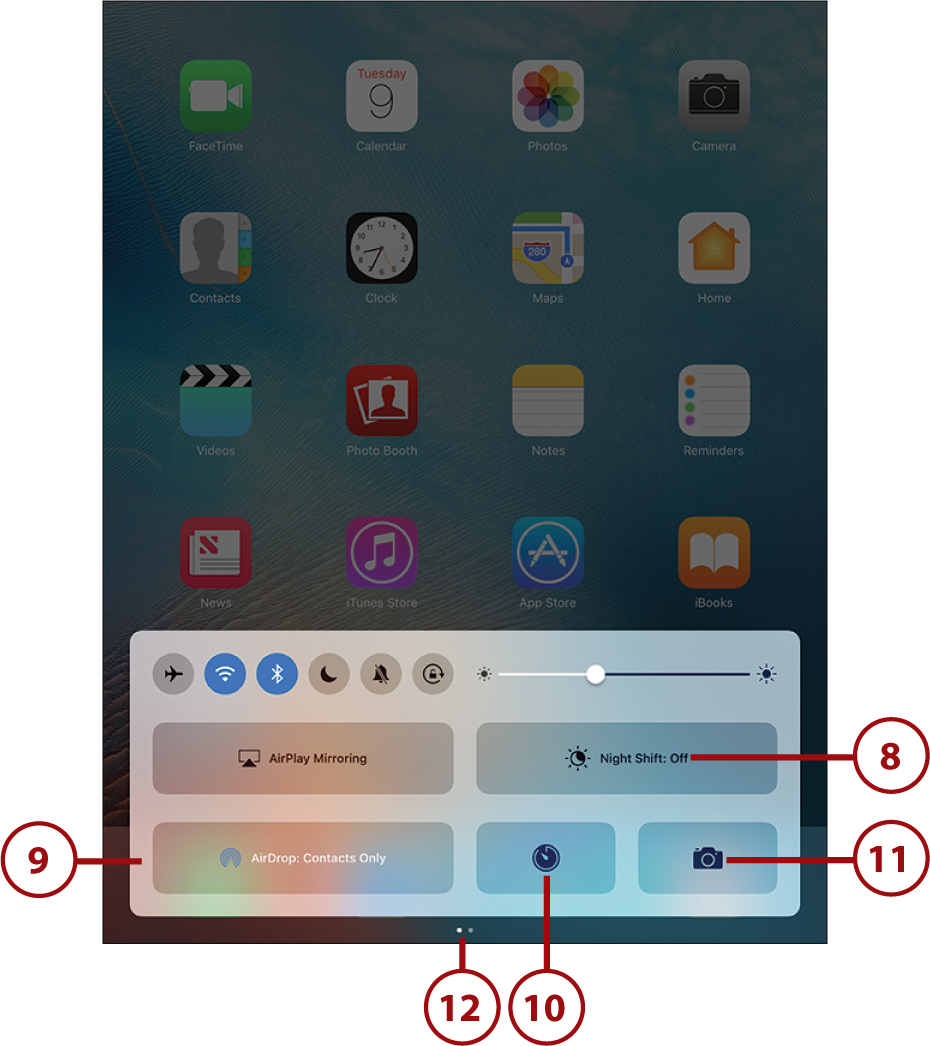
8. The Night Shift control allows you to shift the color of your iPad’s screen for nighttime reading.
9. If you have an iPad that supports AirDrop, this button lets you turn AirDrop on or off. AirDrop is covered in Chapter 3, “Networking and Syncing.”
10. This is a shortcut that takes you to the Timer screen in the Clock app.
11. This is a shortcut that takes you to the Camera app.
12. The two dots indicate that there are two screens to the Control Center. Swipe right to left to go to the second screen.

13. This second screen focuses on music. It shows a summary of what is currently playing.
14. You see a complete set of music playback controls. You can pause or resume the song and adjust the slider to jump around inside the song. You can also skip to the next or go back to the previous song.
15. Move the volume slider to the left to turn down the volume or to the right to turn it up.
16. Choose your AirPlay streaming device. The first option is to play the music on the iPad’s speakers. In this example, the other options are two Apple TVs and a Mac that are on the same network and have AirPlay capabilities. Tapping on an option sends the audio to that device.
17. Dismiss Control Center by tapping the screen above Control Center or simply pressing the Home button.
More Than One Route
There’s not much that Control Center does that cannot be done in the Settings app or the Home screen. Control Center simply provides quick access to a variety of functions.
